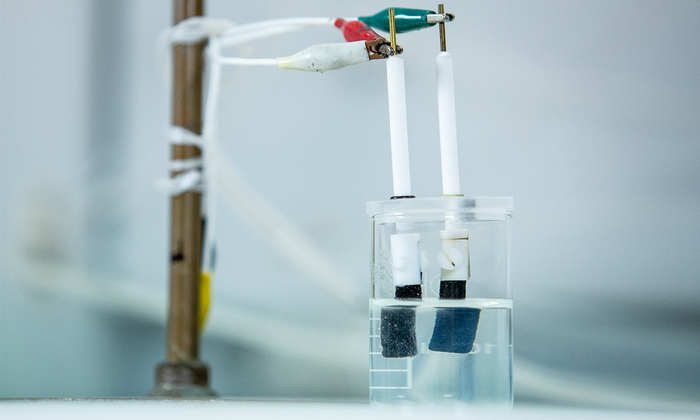In an important step towards a commercially viable green hydrogen industry, researchers have created a less expensive and more energy-efficient method of producing hydrogen straight from saltwater.
 The new method from RMIT University researchers splits seawater directly into hydrogen and oxygen—skipping the need for desalination and its associated cost, energy consumption, and carbon emissions. Image Credit: RMIT University
The new method from RMIT University researchers splits seawater directly into hydrogen and oxygen—skipping the need for desalination and its associated cost, energy consumption, and carbon emissions. Image Credit: RMIT University
Researchers at RMIT University have created a new technique that divides saltwater straight into hydrogen and oxygen, avoiding the need for desalination and all of its costs, energy requirements, and carbon emissions.
Especially for sectors that are more difficult to decarbonize, including manufacturing, aviation, and shipping, hydrogen has long been promoted as a clean future fuel and a potential answer to pressing energy concerns.
Almost all of the hydrogen used in the world today is produced using fossil fuels, emitting around 830 million tons of carbon dioxide annually, or almost as much as the United Kingdom and Indonesia put out in a year.
However, the cost of producing emissions-free “green” hydrogen, produced by splitting water, is so high that it is mostly financially unviable and only makes up about 1% of all hydrogen produced worldwide.
Green hydrogen generation technologies, according to the study’s lead researcher Dr. Nasir Mahmood, a Vice-Chancellor’s Senior Research Fellow at RMIT, were both expensive and dependent on fresh or desalinated water.
We know hydrogen has immense potential as a clean energy source, particularly for the many industries that can’t easily switch over to be powered by renewables. But to be truly sustainable, the hydrogen we use must be 100% carbon-free across the entire production life cycle and must not cut into the world’s precious freshwater reserves.
Dr. Nasir Mahmood, Study Lead Researcher and Vice-Chancellor’s Senior Research Fellow, RMIT University
Dr. Mahmood added, “Our method to produce hydrogen straight from seawater is simple, scalable and far more cost-effective than any green hydrogen approach currently in the market. With further development, we hope this could advance the establishment of a thriving green hydrogen industry in Australia.”
The new technique was described in a lab-scale study published in the Wiley journal Small, and a provisional patent application has been made for it.
Splitting The Difference: A Catalyst for Seawater
An electrolyzer is used to divide water into its component elements of hydrogen and oxygen to produce green hydrogen.
It can take up to nine liters of water and costly catalysts to produce one kilogram of hydrogen with the electrolyzers that are available today. They also produce chlorine, which is poisonous.
Mahmood added, “The biggest hurdle with using seawater is the chlorine, which can be produced as a by-product. If we were to meet the world’s hydrogen needs without solving this issue first, we would produce 240 million tons per year of chlorine each year—which is three to four times what the world needs in chlorine. There is no point replacing hydrogen made by fossil fuels with hydrogen production that could be damaging our environment in a different way.”
He continued, “Our process not only omits carbon dioxide, but also has no chlorine production.”
A team from the multidisciplinary Materials for Clean Energy and Environment (MC2E) research group at RMIT has created a new method that makes use of a unique kind of catalyst designed to precisely work with seawater.
The research, conducted with Ph.D. candidate Suraj Loomba, concentrated on creating stable, highly effective catalysts that could be produced at a reasonable cost.
“These new catalysts take very little energy to run and could be used at room temperature,” Mahmood added.
While other experimental catalysts have been developed for seawater splitting, they are complex and hard to scale. Our approach focused on changing the internal chemistry of the catalysts through a simple method, which makes them relatively easy to produce at large-scale so they can be readily synthesized at industrial scales.
Sooraj Loomba, Ph.D. Candidate, RMIT University
According to Mahmood, the technique has the potential to significantly lower the cost of electrolyzers, enough to fulfill the Australian Government’s target for producing green hydrogen at $2 per kilogram, making it competitive with hydrogen derived from fossil fuels.
Aspects of this technology are being developed by academics at RMIT in collaboration with industry partners.
The next phase of the study involves creating a prototype electrolyzer that combines several catalysts to generate enormous amounts of hydrogen.
The study had Suraj Loomba, Muhammad Waqas Khan, Muhammad Haris, Seyed Mahdi Mousavi, Nasir Mahmood, et al. as the co-authors.
Journal Reference:
Loomba, S., et al. (2023) Nitrogen-Doped Porous Nickel Molybdenum Phosphide Sheets for Efficient Seawater Splitting. Small. doi:10.1002/smll.202207310.